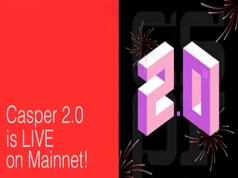Casper 2.0 Officially Launches on Mainnet: Shaping the Future of Digital Assets in the Real World

May 6, 2025 marks a significant milestone in the development journey of Casper Network as Casper 2.0 is officially launched on the mainnet. This is not just a technical upgrade, but a foundation that reshapes the way blockchain interacts with real-world assets, organizations, and processes.
A New Era: Blockchain for the Real Economy
With Casper 2.0, the network moves beyond the traditional limitations of blockchain technology, presenting a bold vision – where blockchain does not simply exist in a separate Web3 ecosystem, but becomes a core part of the global economic system. The combination of crypto-native technological innovation and enterprise-ready infrastructure makes Casper the ideal blockchain for financial applications, digital assets, and business processes.
“Casper 2.0 is the launch pad for a new generation of blockchain applications that are highly practical in industries such as finance, real estate, and data management,” said Matt Schaffnit, CEO and Chairman of the Casper Association.
Core Innovations in Casper 2.0
1. Zug – A New Consensus Protocol with Instant Finality
Casper 2.0 integrates the Zug consensus protocol, which provides instant finality for transactions, making it ideal for transferring assets such as real estate, securities, or crypto-commodities. This ensures that transactions are irreversible and have a clear audit trail – a key element for transparency and compliance.
2. Upgradable Smart Contracts and Fine-Grained Access Control
Unlike many existing platforms, Casper 2.0 integrates decentralized access permissions, multi-signature support, and the ability to upgrade smart contracts without disrupting operations. This allows business processes to be modeled accurately, in line with real-world compliance, audit, and governance requirements.
3. Friendly Development Experience
Casper 2.0 approaches developers in a more practical way: supporting many popular programming languages, providing clear documentation, and modern design patterns that significantly reduce the barrier to entry when building on-chain applications. This makes it easy for millions of Web2 developers to join and contribute to the Casper ecosystem.
4. Flexible Infrastructure, Ready for Complex Applications
Multi-VM support expands Casper’s compatibility and performance, enabling the reliable running of large-scale decentralized applications.
5. Enhanced DeFi and Privacy Integration
Casper 2.0 introduces new features such as native security-based liquidity staking, zero-knowledge hashing for compliance and identity protection, and native token burning to control supply – enabling more flexible economic strategies.
“We designed Casper 2.0 to reflect how assets, processes, and rules operate in the real world – from ownership, to security, to flexible regulatory upgradeability,” said Michael Steuer, CTO and Chairman of the Council.
Rigorous Security Audit
The upgrade has been independently audited by cybersecurity firm Halborn Security, confirming its integrity and compliance with industry-leading security standards – a key factor in attracting businesses and financial institutions.
About Casper Network
Casper Network (token: CSPR) is a layer 1 blockchain using a Proof-of-Stake consensus mechanism, built to serve the real-world needs of businesses and individuals to encrypt, manage, and exchange assets, in both public and private environments. Casper offers instant transaction finality, advanced smart contracts, enterprise-grade security, and flexible integration capabilities, bridging the gap between Web2 and Web3.
